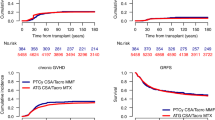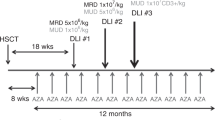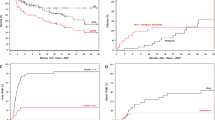Abstract
In an effort to decrease the relapse rate following autologous bone marrow transplantation for non-Hodgkin’s lymphoma, patients were given cyclosporine and interferon following autologous marrow transplantation. Forty patients with intermediate grade non-Hodgkin’s lymphoma that was relapsed or refractory to standard chemotherapy underwent autologous marrow transplantation. The preparative regimen consisted of cyclophosphamide 6.8 g/m2, etoposide 1600 mg/m2, and carmustine 400 mg/m2 over 4 days followed by reinfusion of bone marrow. Intravenous cyclosporine was started on day −1 as a 16 mg/kg loading dose followed by 3.6 mg/kg/day for 28 days after transplant. Patients were begun on alpha-interferon (starting dose, 0.5 million units s.c. every other day) following platelet engraftment (median day 24 post-transplant) and continued on 1.5 million units s.c. daily for 2 years. Regimen-related toxicities resulted in four (10%) deaths. Twenty-one (53%) patients developed marked erythema of the palms, soles, and arms. Biopsies of the erythema were consistent with grade I GVHD. Patients who did not develop rashes were not biopsied. The erythema persisted for a median of 10 days and resolved in all cases without treatment. Visceral GVHD was not apparent. All patients have been followed for a median of 24 months (range 12–54 months). To date, only five patients (13%) have relapsed after bone marrow transplant. Multivariant analysis could not identify risk factors for relapse post-transplant. Disease-free survival of all patients is 77% (95% confidence interval, 67–93%). The results of this pilot study suggest that the administration of cyclosporine and interferon may decrease the relapse rate of relapsed/refractory non-Hodgkin’s lymphoma following autologous bone marrow transplantation
This is a preview of subscription content, access via your institution
Access options
Subscribe to this journal
Receive 12 print issues and online access
$259.00 per year
only $21.58 per issue
Buy this article
- Purchase on Springer Link
- Instant access to full article PDF
Prices may be subject to local taxes which are calculated during checkout
Similar content being viewed by others
Author information
Authors and Affiliations
Rights and permissions
About this article
Cite this article
Gryn, J., Johnson, E., Goldman, N. et al. The treatment of relapsed or refractory intermediate grade non-Hodgkin’s lymphoma with autologous bone marrow transplantation followed by cyclosporine and interferon. Bone Marrow Transplant 19, 221–226 (1997). https://doi.org/10.1038/sj.bmt.1700646
Received:
Accepted:
Issue Date:
DOI: https://doi.org/10.1038/sj.bmt.1700646
Keywords
This article is cited by
-
Pilot study of tandem high-dose chemotherapy and autologous stem cell transplantation with a novel combination of regimens in patients with poor risk lymphoma
Bone Marrow Transplantation (2005)
-
Second autologous transplant with cyclosporin/interferon α-induced graft versus host disease for patients who have failed first-line consolidation
Bone Marrow Transplantation (2004)



